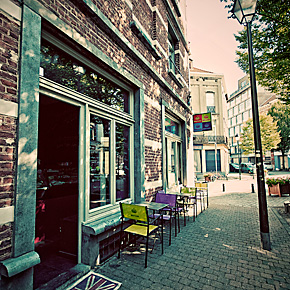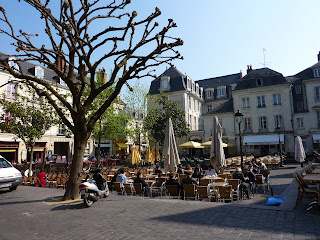 (Wrong Indian! - Ed.)
(Wrong Indian! - Ed.)
Indian food has always been popular in the UK, going back to the days of the Raj - albeit in an Anglicized form. Kedgeree and mulligatawny soup are but two of the many delicious dishes that would be served at a Memsahib’s table back in the days of Gandhi.
Things have changed a bit since Indians started serving their food to the British back in the 1970s. It is no longer a question of a vindaloo and a pint of lager after the pub shuts. North Indian, South Indian, Goan, Kashmiri, Bengali, Mughal – going out for an Indian is no longer just a chicken korma, pilao rice and a pile of pappadoms. The British are quite au fait with Indian cuisine these days, be it the local tandoori or a Marks & Spencer ready meal eaten at home, and most of them have a fairly wide vocabulary of Indian culinary terms: naan, roti, tandoori, thali, dal, dansak, biryani, balti, saag, aloo and paneer are terms that will trip off the tongue of residents of cities almost anywhere in the UK.
We certainly know our pakora from our pappardelle and our Panini from our punani these days, for which we can thank Madhur Jaffrey the TV chef in the 1970s and Patrick Campbell, founder of the Curry Club. Even the Hairy Bikers can whip up a saag ghosht, or lamb and spinach curry, although in a Geordie accent it sounds more like an expletive. The chicken tikka masala is now, apparently, the most popular dish in the UK.

If you are a visitor to the UK and have a penchant for an authentic “Ruby Murray” as our chirpy cockney mates down in Walford would say, head for Brick Lane, near Aldgate East tube. Or if you want to go more upmarket, Veeraswamy’s on Regent Street will take you back to the glory days of the Raj. Birmingham boasts a “balti triangle” where the best balti restaurants this side of Lahore can be found, and in fact the balti – a way of cooking in individual dishes - is reputed to have been invented in that city. Birmingham, not Lahore. Whichever the type of cuisine advertised, in 99 cases out of 100 the chefs and owners will be from Bangla Desh.
Subcontinental food is becoming popular in Belgium too, if the increasing number of Indian restaurants in Brussels is anything to go by. There are now about 40 in Brussels alone. Unfortunately French gastrofascism got its garlicky fingers into Belgian culinary tradition decades ago, and anything that is not in the Larousse Gastronomique is viewed with suspicion, if not outright fear. I met a couple in Paris once who would not go to Chinese restaurants because there was no bread on the table! Indian cuisine is therefore adapted to local palates, which is not always a bad thing. The lower the chilli factor, the more you can taste the subtle blends of spices. However, some lovers of sensations fortes – mainly British men – like a degree of pain with their rogan josh. It’s a macho thing. You won’t find anything in Brussels to compare with Bradford, Leicester or Tooting Bec but have a discreet word with the waiter and most chefs here will turn the heat up a notch or two on request.
In the olden days Indian restaurants were called The Star of India or the Maharajah, and had red flock wallpaper, twangy sitar music and cooking oil drums stacked up in the corridor blocking the way to the loo. Nowadays – in the UK at least – they are all painted in neutral colours with Ikea furniture and venetian blinds and have names like “Monsoon”, “Billy Patel’s” or “Chutney Mary’s”. I blame Danny Boyle. A pair of recently arrived Yanks from the colonies agreed to join me on one phase of my search for a decent curry. “We’re going Indian hunting, cowboys. Call in the cavalry!” I quipped. The lady shuddered. “We call them Native Murkans now and they’re protected,” she said, deadpan. I had a Jeremy Clarkson moment.
We ordered a selection of samosas – two chicken, two vegetable – and a couple of onion bhajis. The samosas were fine, although not remotely spicy, more like triangular Cornish pasties, and the onion bhajis were tasty but about the size of a truffle. For main course we shared a lamb danzak, a chicken tikka masala and a vegetable curry. The lamb danzak was generally judged to be the most tasty of the three, the taste of lentils came through unswamped by fiery spices. The vegetable curry was mild but flavoursome all the same. The chicken TM was the colour of a radioactive carrot. We asked the waiter what they put in it. He insisted just paprika and general masala spices. Otis swore he could detect something like ketchup in the sauce. I couldn’t bring myself to tell him the possibly apocryphal legend that the CTM was invented by a chef at the Shish Mahal restaurant in Glasgow who whipped up an improvised sauce using a tin of Heinz tomato soup. With one garlic nan, one plain nan, and two portions of basmati rice, the whole lot came to around 26 euros a head. The waiters are smiling and nice but don’t expect the sort of expertise or banter you’d get in Sauchiehall Street.

Personally I find wine a bit wasted with curry, as it all tastes the same with the strong spices, and Indians themselves recommend drinking either beer or lassi (fermented milk) with their food. Indian beers such as Cobra and Kingfisher are brewed under licence in the UK, and have been designed especially for drinking with curry, having a lower gas content. If you follow me.
I ventured to the Koh-i-Noor on Avenue de la Chasse with another colonial, this one from the land of the long white cloud#. This small, unprepossessing establishment must have taken over the premises of a Swiss fondue chalet if the décor is anything to go by. Wood panelled walls made me feel I was inside a cuckoo clock. One little lady in a sari runs this place single handedly, she does all the cooking and serving, and goes as fast as she can, but we did wonder if the kitchen was in the same street. The place is not exactly heaving on a Friday night – in fact there were just the two of us. This would seem to be more due to lack of appreciation of Indian cuisine from the locals, or possibly the off-centre location, than on the quality of the food which, when it did arrive, was extremely good. We munched on a pappadom and worked our way through a bottle of Beaujolais while we waited for our large plate of mixed entrees, which comprised 2 samosas (one meat one veg), an onion bhaji, pieces of chicken tandoori, chicken tikka, lamb tikka, shik kebab and a little side dish of mint yogurt. By the time we’d worked our way through these, the main courses were ready: a chicken tikka masala that was reddish but didn’t glow in the dark, a lamb badam pasanda, a vegetable biryani to share and a side order of vegetables. All the food was freshly cooked, including the garlic naan which was the best I have tasted anywhere. A second bottle of Beaujolais at 17 euros was required due to the slow service, which whacked the bill up a bit to just over 40 euros a head, but I cannot fault the food which was delicious.

The third in my trio of Indians is Annapurna on Rue de Laeken which advertises Indian, Bengali, Tibetan and Nepalese dishes, and is named after one of the highest peaks of the Himalayas. I popped in for a quick standard menu (samosas - chicken tikka masala - basmati rice) with a French friend. The waiters are sweet and speak good English, although they can barely speak French. It was quite busy, and they obviously weren’t used to dealing with a full house. We tried to channel the patience of Sir Edmund Hillary and Sherpa Tensing on the first conquest of Everest while waiting for the food, but we had the impression that base camp was quite a long way down. It finally dawned on them that they’d forgotten us. Some panicking in the kitchen, and we finally got our meal - which was delicious. I can’t fault the food, but avoid it on a weekend, they haven’t quite come to terms with their own success, yet.
Indian restaurants here are somewhat timid in their cooking, and in none of these three did the waft of curry spices hit you as soon as you walked in. If you are a novice where Indian food is concerned, Brussels is probably a good place to start. If you are a Brit desperate for a really good curry, London is only two hours away on Eurostar.

Spicy Grill
Rue Stevin 102
1040 Etterbeek
Tel: 02 512 25 05
http://www.spicygrill.be
Koh-i-Noor
Avenue de la Chasse 123
1040 Etterbeek
Tel: 02 736 50 22
http://restaurantkohinoor.be
Annapurna
Rue de Laeken 26
1000 Bruxelles
Tel: 02 219 3933
http://web.resto.com/annapurna/
Veeraswamy’s
Swallow Street
(off Regent Street)
London W1
Tel : +44 20 7734 1401
http://www.veeraswamy.com/























